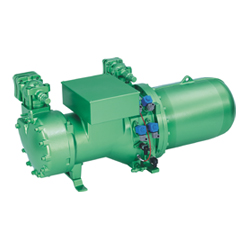Screw compressors
 Screw compressors are based on a mechanism made up of two intermeshing screws, called rotors. As the rotors revolve, the fluid is drawn in through the inlet port, filling the volume between two lobes.
Screw compressors are based on a mechanism made up of two intermeshing screws, called rotors. As the rotors revolve, the fluid is drawn in through the inlet port, filling the volume between two lobes.
When the spaces between the lobes are full of fluid, suction ceases, the fluid between the lobes is then forced due to rotation into an increasingly small space, causing compression. When the lobes reach a certain position, the compressed fluid is completely discharged through the outlet port.
These compressors require abundant lubrication due to the meshing of the two rotors. Abundant lubrication and subsequent cooling of the oil using a special heat exchanger guarantee higher compression ratios than reciprocating compressors, meaning wide use in both refrigeration (compressor racks) and air-conditioning (large chillers operating on R410A)
Finally, a sliding valve mechanism that opens a passageway between the inlet and the compressor casing in a position where the rotors have already partially compressed the fluid allows a reduction in refrigerant flow, down to 25% of the maximum, thus guaranteeing greater efficiency, albeit not to a significant extent, in lower load conditions.
The sliding mechanism can provide either continuous or step modulation of the cooling capacity thanks to special solenoid valves managed by electronic controllers.
Related Products and Applications
| c.pCO sistema |  |
| pCO sistema |  |
| AC inverter |  |
| Chiller/Heat Pump units |  |
| Compressor Racks |  |
Do you need more informations? KNOWLEDGE CENTER
KNOWLEDGE CENTER
